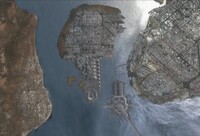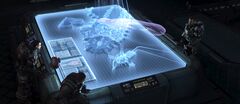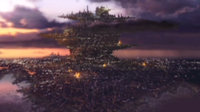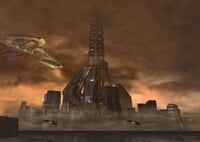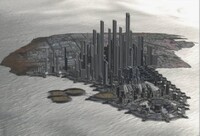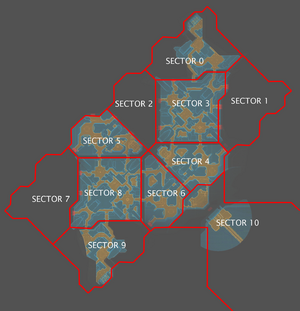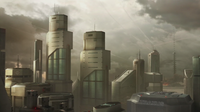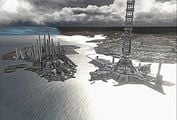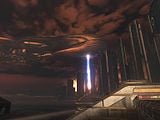New Mombasa: Difference between revisions
From Halopedia, the Halo wiki
(→Trivia) |
m (Reverted edits by 137.191.244.231 (Talk) to last version by Jugus) |
||
| Line 151: | Line 151: | ||
*In ''[[Halo 3: ODST]]'', there are multiple buildings belonging to [[Jotun Heavy Industries]], first mentioned in ''[[Halo: Contact Harvest]]''. | *In ''[[Halo 3: ODST]]'', there are multiple buildings belonging to [[Jotun Heavy Industries]], first mentioned in ''[[Halo: Contact Harvest]]''. | ||
*The ''Halo 2'' E3 demo-era design of the city was shown as a Forerunner structure covered in Flood biomass in the ''[[Halo Legends]]'' episode, ''[[Origins]]''. | *The ''Halo 2'' E3 demo-era design of the city was shown as a Forerunner structure covered in Flood biomass in the ''[[Halo Legends]]'' episode, ''[[Origins]]''. | ||
==Gallery== | ==Gallery== | ||
Revision as of 11:19, January 7, 2010
Template:Ratings Template:City
- "This is the only place on Earth the Covenant decided to land. That Prophet is going to tell us why."
- — Admiral Terrence Hood
New Mombasa was a major port city and industrial center on Mombasa Island in Kenya, in the East African Protectorate on Earth. It was the main target of the initial Covenant attack in the Battle of Earth.[1] The city was invaded, occupied, and destroyed in the course of the conflict. On the mouth of the river north of the island is the New Mombasa Orbital Elevator, a dominant feature of the city skyline. Old Mombasa is located on the mainland north and south of the island. Like Earth's other tether cities, New Mombasa's infrastructure was managed with the help of a second generation "dumb" AI, the Superintendent.[2]
Description
The dramatic rise of sea levels has changed the coastlines of Mombasa Island and its surroundings. This has also forced a seawall to be built around the city, in order to prevent it from being flooded. A highway runs along the seawall surrounding the island.[2] While the island was originally about as wide on the north as on the southern side, this has changed due to sea levels rising. Despite them dropping at some point, large areas of former land still remain underwater. A notable example of this is the mainland northwest of the island; while originally a large peninsula, this landmass is now completely underwater.
The nothern side of the island still retains more of its original width than the southern section protruding from it. There, sea has occupied larger areas of land, leaving the southern half much more narrow. The narrow southern half houses the city center and the business districts of the city, while on the northern side, industrial structures are more prevalent.[2]
From the nothern side of the island, a massive suspension bridge connects the island to the mainland. Starting at some point near the city center, the highway NM 105 E leads over the bridge, to the old city. Near the end of the bridge on the island is New Mombasa's industrial district, where companies such as Tterrab Industries have their headquarters. Here are also located multiple gargantuan industrial buildings, some with sky bridges connecting them.[3]
In the center of the island there is a concentration of gigantic corporate skyscrapers, the highest - the Vyrant Telecom building - being 2 kilometers tall.[4] The size of the structures changes towards the south, with more lower-case buildings. The layout of the southern side of the city is also near-symmetrical, and it is divided to ten sectors. Between the city center housing highest skyscrapers and the southern sections of the city, there is a district with middle-sized skyscrapers. The NMPD Headquarters is located here. The city center is elevated above normal ground level, and surrounded by slope-like walls resembling the seawall around the island.
The Office of Naval Intelligence has an important office building on the southeast end of the island. The building is surrounded by a pool of water and an additional wall similar to the sea wall surrounding the whole island. Northeast of the Alpha Site, a large artificial island has been constructed to house the Orbital Elevator. This island is full of port structures, including warehouses, docks and cranes. train lines connect the island to the mainland. A highway and a train line connect New Mombasa to Voi and Nairobi, with multiple highways leading to different parts of the continent.
Uplift Nature Reserve, a large park and a wildlife reserve, resides south of the island. The city also contains a massive network of underground installations, such as the Superintendent's data center deep beneath the surface. The facility consists of multiple levels, and on the tenth and final level, in a massive cavern with an underground lake on the bottom, resides the AI's data core.[2]
History
Mombasa

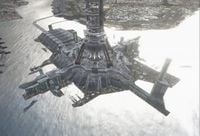
Mombasa had always been an important port of the Indian Ocean trade routes and was captured and recaptured countless times by a variety of powers including Portugal, the United Kingdom, and various Arab forces. This violent history led to its Swahili nickname "Kisiwa Cha Mvita", or "Island of War". The city became part of the independent nation of Kenya in the 20th century. During this era, Mombasa became a tourist destination, boasting numerous resorts and clean white beaches. It was also important as a port city, connecting East Africa to the Indian Ocean.
Formation of New Mombasa
In 2302, due to its economic stability and prominent location, New Mombasa—at that time the world's busiest sea port—was chosen to be Earth's first Space Elevator city. The elevator transformed the city; New Mombasa became one of the most important cities on Earth.
Over the next eleven years the city experienced explosive growth, but nothing compared to what followed. The city grew out as well as up, its urban sprawl unequaled throughout the continent. An influx of trade, citizens, and jobs drastically changed the landscape of the city. Within a century older housing and hotels on Mombasa Island were replaced with vast industrial complexes and gleaming office towers.
Mombasa would change dramatically with the arrival of the interstellar era. By 2430, New Mombasa had absorbed the entire island and many of the surrounding towns, which became overrun by residents of Mombasa. The switch of name was never official, and though many of the neighborhoods within direct line of sight to the Mombasa Tether still distributed newspapers and chatter directories under their previous names, all municipalities within a 74 km radius of the island became referred to as "Old Mombasa".
By the 26th century the city was a dynamic, cosmopolitan metropolis, boasting such amenities as a mile-long suspension bridge, a highly efficient MagLev Train system, an automatic highway network, a large police department, and large-scale recreational areas.
While the majority of New Mombasa has been divided to numbered sectors, some districts such as Mbaraki, Kizingo or Kikowani still retain their original names. The original names are often seen in the names of streets or train stations, for example. Some of the districts' names have changed, albeit slightly; areas originally referred to as Tangana and Liwatoni are now referred to as Tanaga and Liwitoni, respectively. The locations of some districts have changed as well. This is the case with most of the districts on the southern side of the island, where the sea has claimed large areas of land.
The Covenant Invasion
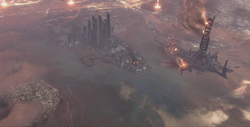
- Main article: Battle of Mombasa
On October 20th, 2552, a small cluster of Covenant capital ships exited Slipspace just off of Earth's defensive network. During the ensuing battle, a Covenant Assault Carrier breached the orbital fortifications and made its way to the surface. The ship, which carried the Covenant Hierarch known as the High Prophet of Regret, took position over New Mombasa, deploying troops and vehicles which occupied the city. The city's civilians either evacuated, took shelter, or were killed. In Old Mombasa, announcements in Swahili are broadcast over a public address system. These announcements encourage New Mombasa's citizens to fight against the polytheistic "alien zealots."[5]
The Master Chief arrived in Old Mombasa to help UNSC forces liberate the city from the Covenant. After fighting through the maze-like streets of the mainland, the Master Chief crossed the empty beach below the seawall and then entered the highway system and the bridge to New Mombasa. After a series of quick battles in a public park and the city streets, the Chief boarded and destroyed a Covenant Scarab as it passed through the city's artificial canals. Instantly after destroying the Scarab, the Chief returned to the In Amber Clad. At this point, the Covenant troops were retreating back into the Prophet's Assault Carrier, which was preparing to leave. Meanwhile in orbit, an ODST force was preparing to attack the Assault Carrier. While the ODSTs were on their way down, the Covenant ship jumped into Slipspace, with the In Amber Clad in pursuit.
The ensuing shockwave and EMP filled the whole city, causing heavy damage to most structures, and scattering the ODSTs' drop pods around the city. Their eventual fate is unknown, though at least six survived landing. Although the whole of Mombasa Island was consumed by the explosion, only the buildings close to the Slipspace vortex were sucked through. The slipspace rupture also created a large crater to the mainland north of Mombasa island. This was where the Covenant would eventually begin their excavation for the Forerunner structure under the region.
After the Slipspace event, a Covenant occupation force led by Brutes arrived at the city. The remaining UNSC Marines and NMPD fought against the Covenant occupiers for the rest of the day. Eventually, a larger Covenant fleet appeared over the city, glassing it in order to uncover the Forerunner structure the city was built over. After a costly holding action, the surviving Marine and ODST forces were forced to abandon the city as it was glassed by the Covenant.[2]
Appearances
The overall appearance and shape of the city of New Mombasa have changed greatly over the years, but the general architectural direction has stayed fairly similar.
Halo 2 E3 Demo
In the E3 presentation of Halo 2, the city appeared vastly different from its later versions.
The New Mombasa Orbital Elevator was nowhere to be found. Instead, the Space Elevator's site in the heart of the city was occupied by a massive tower shaped like an African Baobab tree, composed of massive skyscrapers, and surrounded by spires. The city was much larger than its future incarnations, with the urban metropolis sprawling into the horizon as far as one could see. The internal architecture of the city also differed greatly in the final version of Halo 2.
Halo 2
In Halo 2, the city was shaped more like its real-world counterpart, with the metropolis residing on the Mombasa island instead of the whole surrounding area having been filled with a gargantuan megalopolis. The space elevator was located in the city center, surrounded by massive skyscrapers. A large artificial canal cut through the island, built to house dock facilities for the space elevator. The city's streets appeared more simple and plain than in the E3 Demo, although with more trees and plants.[3] An effort had been made to try to design the city as realistically as possible. "What would the city look like after 500 years of advancement?"
Halo 3
New Mombasa is not seen for much of the duration of Halo 3, but if one looks across from the Artifact they can see the smoking ruins of the city in the distance. Most of the action on the ground takes place around the market city of Voi instead.
Halo 3: ODST
The city's architecture was changed again considerably in Halo 3: ODST. While the areas seen in Halo 2 are not visited, the city's in-game model from in the level Prepare to Drop reveals that the large canal cutting into the island seen in Halo 2 is absent. It should be noted that this implies that the Scarab boarding event that took place during Halo 2 could not have occurred, at least not in the same way as it did, as the side passage of the canal that the Scarab walked down no longer exists. It is unsure of how this phenomena is resolved. The northwest side of the island is also much more angular than the Halo 2 version, which mostly followed the shape of the real-world Mombasa island. The famous bridge crossed in Halo 2 has been lengthened by close to a 100 meters.
The skyscrapers in the city appear more sleek and tall than in Halo 2. The orbital elevator's base now resides away from the city centre, surrounded by water at all sides. Its base structure is different, notably being less immense in size than in Halo 2. The internal architecture of the city is much more detailed, with the streets ramping up and down, and elevated walkways surrounding them and . In many ways, it resembles the city seen in the E3 2003 demo more than the Halo 2 iteration, albeit with much more detail. The "hub" area visited in-game is essentially symmetrical, and divided to ten sectors. The Superintendent is also a feature introduced in ODST.[2]
Organizations
- New Mombasa Police Department (NMPD)
- New Mombasa Transit Authority (NMTA)
- New Mombasa Waste Management (NMWM)
- New Mombasa Parks and Recreation (NMPR)
Locations
|
|
Trivia
- Tterrab Industries, a corporation in downtown New Mombasa, is Bungie level designer Chris Barrett's name reversed. "Mtangulizi Kampuni," printed on a welcome mat at the entrance to the building that leads to the canals, is Swahili for "Forerunner Company".[6]
- Originally, it was assumed that the slipspace jump of the Prophet of Regret's Assault Carrier had completely destroyed the city, creating the crater seen later in Halo 3. It was revealed in Halo 3: ODST that it did in fact create a crater, although much smaller than what was originally assumed. This crater was where the Covenant begun their excavation of the Forerunner structure, the Artifact.
- In Halo 3: ODST, there are multiple buildings belonging to Jotun Heavy Industries, first mentioned in Halo: Contact Harvest.
- The Halo 2 E3 demo-era design of the city was shown as a Forerunner structure covered in Flood biomass in the Halo Legends episode, Origins.
Gallery
- Earthcity colormatte.jpg
Early concept art for Halo 2.
- MombasaMap.jpg
A Halo 2-era map of New Mombasa. Note that the city's layout changed considerably in Halo 3: ODST, making this map obsolete.
- Mbaraki.png
A map of New Mombasa, with major locations marked.
- Background2NM.jpg
The Tanaga district of New Mombasa after Regret's Assault Carrier jumped inside of the city.
- Halo3-ODST EnvConcept-12.jpg
Concept art for the damaged New Mombasa.
- Concept tether.png
Concept art of New Mombasa after the slipspace incident.
- Concept tunnel color.png
An indoors area in the city.
The city in the "Keep it Clean" teaser.
- New MombasaODST.jpg
New Mombasa at dawn.
New Mombasa being glassed.
Sources
- ^ Lord Hood: "This is the only place on Earth the Covenant decided to land. That Prophet is going to tell us why." --Outskirts
- ^ a b c d e f Halo 3: ODST
- ^ a b Halo 2
- ^ Measurable by using pan-cam coordinates: the height cap is at 615 WU, the building extends a bit over that, and 1WU=~3meters
- ^ http://nikon.bungie.org/misc/h2dialogue.html?cat=swahili
- ^ The Internet Living Swahili Dictionary
